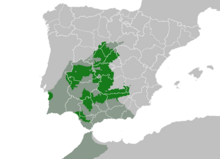Spanish imperial eagle
| Spanish imperial eagle | |
|---|---|
 |
|
| Immature | |
| Scientific classification | |
| Kingdom: | Animalia |
| Phylum: | Chordata |
| Class: | Aves |
| Order: | Accipitriformes |
| Family: | Accipitridae |
| Genus: | Aquila |
| Species: | A. adalberti |
| Binomial name | |
|
Aquila adalberti C. L. Brehm, 1861 |
|
 |
|
| Synonyms | |
|
Aquila heliaca adalberti |
|
Aquila heliaca adalberti
The Spanish imperial eagle (Aquila adalberti), also known as the Iberian imperial eagle, Spanish eagle, or Adalbert's eagle, is a threatened species of eagle native to the Iberian Peninsula. The binomial commemorates Prince Adalbert of Bavaria.
Formerly, the Spanish imperial eagle was considered to be a subspecies of the eastern imperial eagle, but is now widely recognised as a separate species due to differences in morphology,ecology, and molecular characteristics.
The Spanish imperial eagle averages 2.5–3.5 kilograms (5.5–7.7 lb), 78–82 centimetres (31–32 in) in length and 180–210 centimetres (71–83 in) in wingspan, and darker than its eastern cousin, and is a resident species (the eastern imperial is partially migratory). It feeds mainly on rabbits, but can prey on many other animals, such as partridges, rodents, hares, pigeons, crows, ducks, foxes or—rarely, since they are not typically present in the eagle's habitat—small dogs.
The species occurs in central and south-west Spain and adjacent areas of Portugal, in the Iberian peninsula. Its stronghold is in the dehesa woodlands of central and south-west Spain, such as in Extremadura, Ciudad Real and areas in the north of Huelva and Seville's Sierra Norte.
...
Wikipedia

